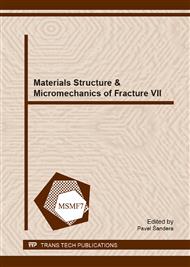p.401
p.405
p.409
p.413
p.417
p.421
p.425
p.429
p.433
Nanoindentation of Thin Copper Coatings
Abstract:
The structure of interest is a thin, metallic coating of fcc copper, of thickness down to a few nanometers only, resting on a stiffer substrate. The elastic and plastic properties of the thin coating using nanoindentation under different geometrical features such as size of the indenter and coating thickness are determined. The force-displacement curve is monitored during indentation and the precise conditions for the occurrence of so called pop-ins during loading are investigated. To simulate the nanoindentation process, a molecular dynamics approach is used, where an infinitely stiff indenter is pushed into the coating under displacement control. The coating is modeled as a thin rectangular plate, with the bottom atom layers locked from movement, simulating the stiffer substrate, and periodic boundary conditions in the plane of the plate are applied.
Info:
Periodical:
Pages:
417-420
Citation:
Online since:
November 2013
Authors:
Keywords:
Price:
Сopyright:
© 2014 Trans Tech Publications Ltd. All Rights Reserved
Share:
Citation:


